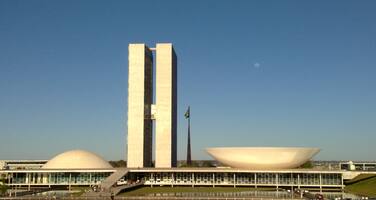Brasilia
Factors affecting the property in 2004*
- Management systems/ management plan
Factors* affecting the property identified in previous reports
Urban Pressure; Lack of institution coordination.
International Assistance: requests for the property until 2004
Total amount approved : 42,000 USD
| 2000 | Organisation of the sixth DOCOMOMO International ... (Approved) | 12,000 USD |
| 1997 | Symposium on the Preservation of Contemporary Heritage: ... (Approved) | 30,000 USD |
Missions to the property until 2004**
Conservation issues presented to the World Heritage Committee in 2004
On 3 February 2004, the Secretariat received progress reports from the Instituto do Patrimônio Historico e Artistico Nacional (IPHAN) and the Under-Secretariat for Urban Planning and Preservation of the Government of the Federal District, on the design and implementation of the Master Plan for the protected area of Brasilia. During 2002, on the basis of the November 2001 joint UNESCO-ICOMOS monitoring mission, a methodological basis for the design of a Master Plan had been set up. The process of elaborating the Master Plan is being supervised by the Secretariat for Urban Development and Housing, through its Under-Secretariat for Urban Planning and Heritage Preservation, coordinated by the Brasilia's Preservation Board.
The Plan is characterized by a participatory process that involves integration between government and society, whose organizational structure includes: Management Council for Brasilia's Preservation Area (Conselho Gestor da Area de Preservaçao de Brasília - CONPRESB), the Executive Group composed of, among others, 21 members from government organizations, teaching and research institutes, the civil society, the productive sector, non-governmental institutions and from member communities that are directly associated with the plan's target areas, a Technical Team composed of specialists from the State Secretariats and from Regional Administration Units, and finally the City Forum, whose members meet during specific stages of the process to discuss proposals made by the society as a whole.
Over the course of several meetings, a need for preliminary studies and documents was established in order to guide the Technical Teams. The priority technical studies, which were started in 2002 and continued throughout 2003, included:
a) "Characterization of Lake Paranoá's Shore and its Model for Development", which was completed in 2003 and consists of a full diagnosis of the parts of Lake Paranoá's shore that are part of Brasilia's Area of Preservation with the objective of evaluating the degree to which Lúcio Costa's principles for this specific area contrast with the current demands to facilitate the establishment of general guidelines to be considered in the Master Plan.
b) The partially concluded study "Superquadra: Time and Space" (superquadra is the name given to each set of residential buildings that are part of the Plano Piloto). The first phase of this study includes research of and reflection upon Brasilia's superquadras and the main result is of which of the suggested guidelines for regulating the use and occupation of the penthouses and stilts of residential buildings.
c) The study "Criteria for Preservation", in conjunction with the results obtained from work carried out by another group (the Scales Group), will yield legal proposals that will integrate the corresponding law ruling over general guidelines and legislation pertaining to territorial planning, fundamental rules for land use and occupation, legal instruments for urban policies, in addition to the institutional means that are necessary for the implementation, approval, continuity and review of such tools.
The perspectives for 2004 include the implementation of the results of the work groups to establish partnerships to financially subsidize the elaboration of the Master Plan (Plano Diretor), to execute various socio-economic surveys, monitor and elaborate directed public questionnaires, study and compose the City's Forum, and host the First Seminar of the Master Plan for Brasilia's Preservation Area.
ICOMOS commended the Brazilian authorities because the progress reports show how both IPHAN (Institute for the National Historic and Artistic Heritage) and GDF (Federal District Government) are concerned with the conservation of the World Heritage property and its environs, and to what extent the recommendations from the 2001 monitoring mission have been taken into account. Both reports described in detail actions undertaken and currently in progress. The two organisms started working together in 2002 through the Inter-Institutional Technical Group (GTI) and further efforts should be made to strengthen common work and to reach a common understanding. It is evident that IPHAN has a critical view on some actions developed by the local government. Both IPHAN and GDF should be encouraged to continue with the task in the framework of a close mutual co-operation.
Summary of the interventions
Decisions adopted by the Committee in 2004
28 COM 15B.108
The World Heritage Committee, 1. Taking note of the reports transmitted by the State Party containing information on the design and elaboration of the Master Plan for the protected area of Brasilia (Decision 27 COM 7B.85), 2. Encourages a continued and strengthened co-operation between Instituto do Patrimônio Historico e Artistico Nacional (IPHAN) and Federal District Government (GDF); 3. Requests the State Party to keep the Committee informed on the further elaboration of Brasilia's Master Plan.
Draft Decision: 28 COM 15B.108
The World Heritage Committee,
1. Taking note of the reports transmitted by the State Party containing information on the design and elaboration of the Master Plan for the protected area of Brasilia,
2. Encourages a continued and strengthened cooperation between IPHAN and GDF;
3. Requests the State Party to keep the Committee informed on the further elaboration of Brasilia's Master Plan.
* :
The threats indicated are listed in alphabetical order; their order does not constitute a classification according to the importance of their impact on the property.
Furthermore, they are presented irrespective of the type of threat faced by the property, i.e. with specific and proven imminent danger (“ascertained danger”) or with threats which could have deleterious effects on the property’s Outstanding Universal Value (“potential danger”).
** : All mission reports are not always available electronically.


